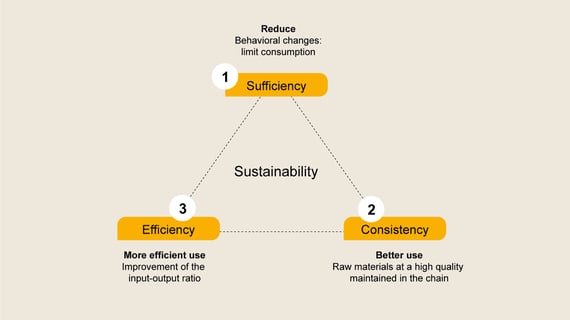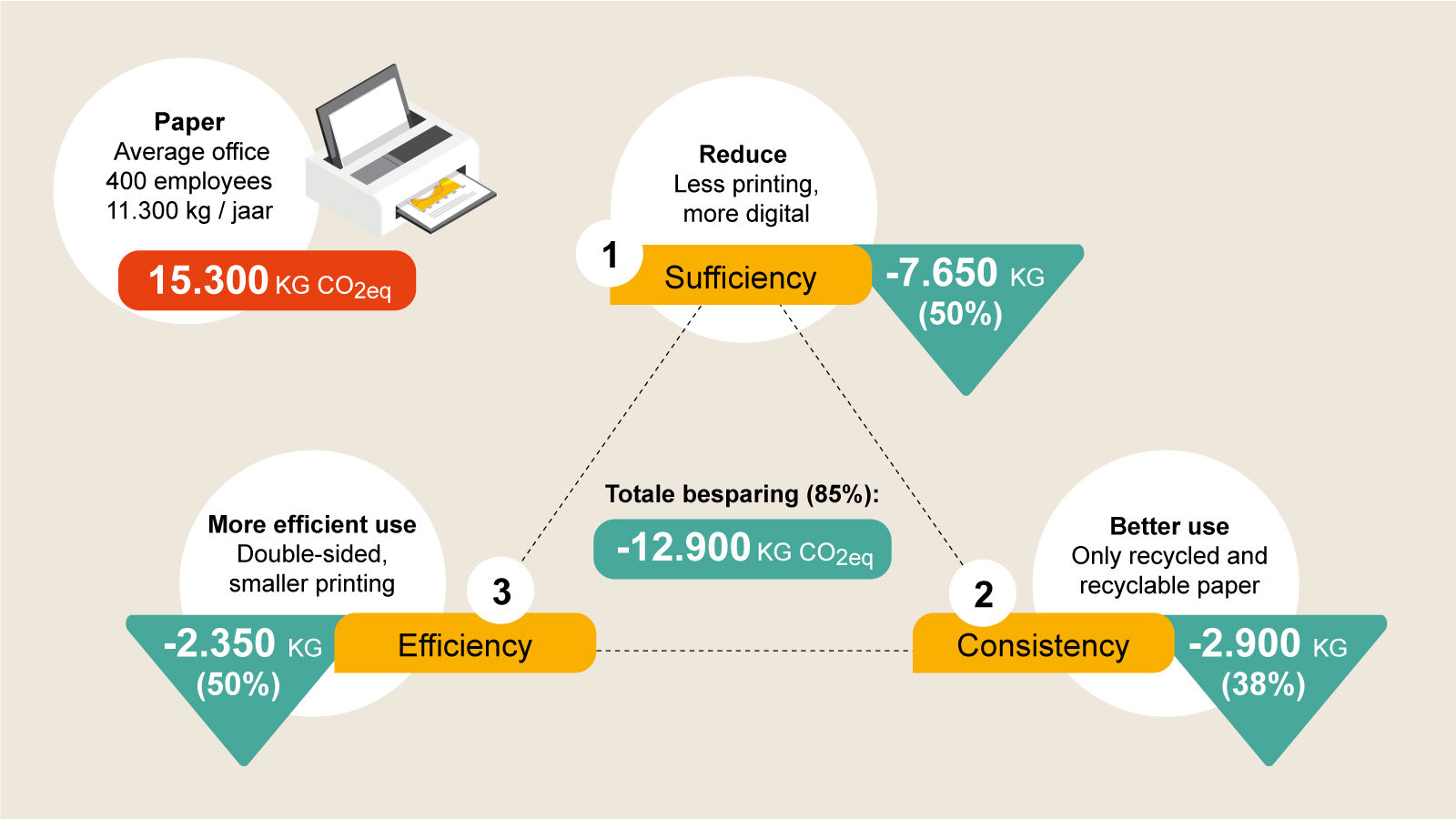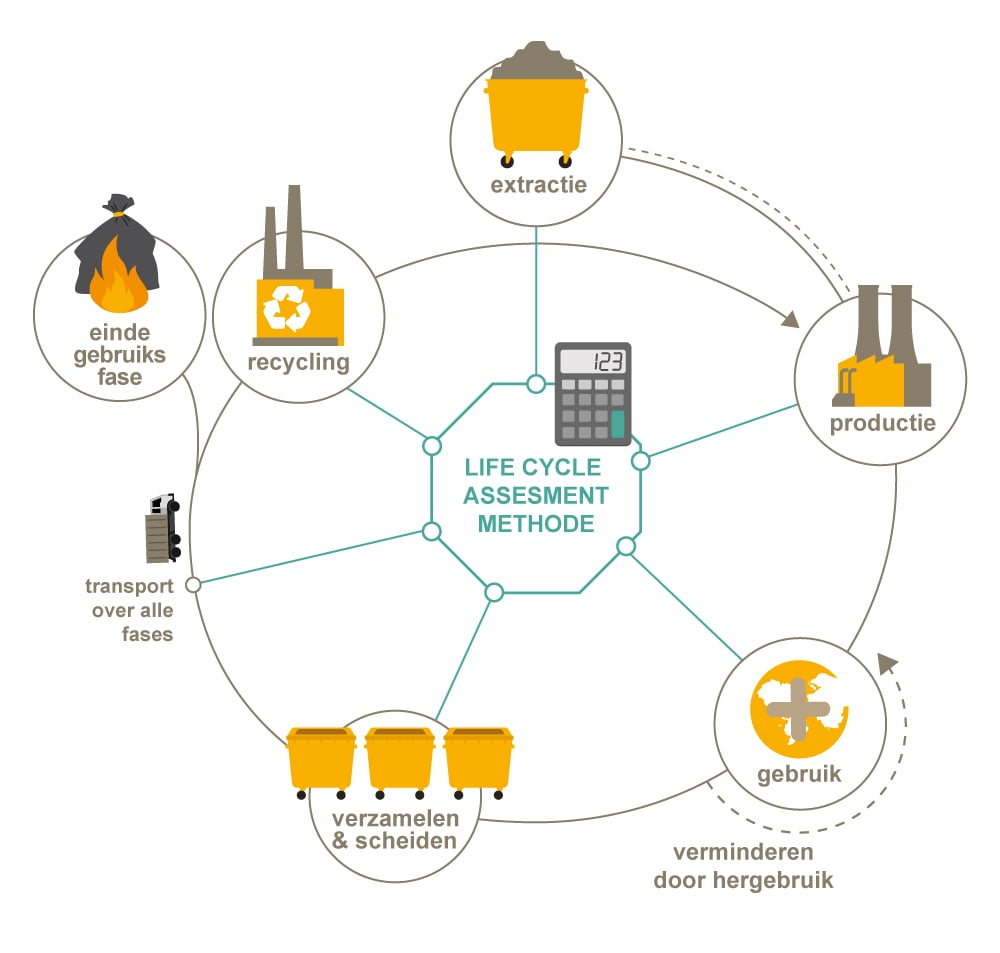You could print this article. Just because it reads easier from paper. If you print it double-sided and on the most efficient print mode, that already saves a little environmental damage. Printing on recycled paper is one more step. You can also choose not to print this article. What is the CO2 impact of paper? And how do you reduce it? Milgro has figured it out.
Let's take an example. An average office, with 400 employees. Every year, each employee uses about 5,000 sheets of paper, for all kinds of reports, e-mails, letters and possibly this article. That makes a total of 2 million A4s, or 11,475 kg. Apart from costing a little over 30 trees, the annual paper use is equivalent to the CO2 emissions of 15,232 kg CO2 equivalents1, when this paper goes in the residual waste2. That's the same as flying around the world twice.
How to calculate the CO2 impact of paper use
We calculate the environmental impact of paper use over the entire life cycle. Starting with:
- The production of paper; that costs 1.02 kg of CO2 per kg of paper.
- Then transportation to the processor, which accounts for 0.16 kg of CO2 per kg of paper.
- Processing the paper into recycled paper costs 0.53 kg CO2 per kg paper.
- Recycling creates positive environmental impact, avoiding 0.88 kg of CO2 emissions per kg of paper. Keep in mind that paper cannot be recycled indefinitely.
This brings the total CO2 impact of paper to 1.71 kg CO2 per kg paper. If you collect paper separately and have it recycled, that makes a difference. Then the impact is 0.83 kg CO2 per kg. For the company with 400 employees, that comes out to 9,450 kg of CO2 emissions for waste paper that is neatly presented for recycling. So separating paper properly saves 38%. Because separating paper has now become common practice, we are using this as a starting point for further reducing the CO2 impact of paper.
Read also

CO2 emissions and waste streams
Strategies to reduce emissions from paper
Companies have three strategies to reduce emissions from paper use, namely less, better and more efficient3. We calculated the effectiveness of each strategy for this above example.

Strategy 1: reduce paper use (sufficiency)
The first strategy is as logical as it is effective: use less paper. The organization in the example will have to manage behavioral change among its 400 employees so that they choose not to print anymore. Instead, they use digital documents, newspapers and magazines. The classic way of steering for behavior change is to inform employees and discourage printing.
You can also make it easier for employees not to print. For example, by digitizing work processes so that quotes, invoices and contracts no longer need to be printed out. There are also digital notebooks on the market that eliminate printing and paper use. With this strategy, halving emissions is quite feasible. In the example mentioned, this would mean 4,725 kg less CO2 emissions, equivalent to the emissions of 250 kg of meat. Of course, it is also possible to take the strategy further and create a completely paperless workplace. This will reduce emissions from the paper waste stream to zero4.
If you want to work with your organization to reduce carbon emissions from paper use, it is smart to start with this first strategy. First, because this strategy has the potential to get emissions to zero. Second, because it is the most effective way to cut costs. At the same time, it is also a challenging strategy because it demands a lot from employees. That is also why it is often chosen to start with the purchase of better paper.
Strategy 2: better paper use (consistency)
How sustainable is the paper used in the office? Paying attention to the quality of the paper can reduce CO2 emissions from paper use. For example, there are companies that only buy recycled paper that can be recycled. Companies do not save paper directly, but they do save CO2 emissions, up to about 38%. This strategy is relatively easy to implement, but it does not save money. In fact, it is often more costly. Organizations experience the choice of quality as meaningful.
Strategy 3: more efficient use of paper (efficiency)
By using paper more efficiently, organizations can also reduce their environmental impact. Consider double-sided printing, more text on a page by using a smaller font size, or printing only in black and white. Another way to reduce the impact of paper use is to put printers on the most energy-efficient setting. Some companies choose to produce economical print versions in addition to their glossy digital issues. This third strategy can easily reduce about 50% of emissions from paper use. This strategy is simple on the one hand because changing printer settings already has an immediate effect. On the other hand, employees may find the adjustments restrictive.

Also getting started with paper? Or better, without paper!
Conclusion, the potential environmental gain is greatest with the first less (sufficiency) strategy. Which fits seamlessly with a zero-waste strategy. So don't print this article. The combination of the three strategies is most effective if your organization is not yet ready to completely eliminate paper use. Combining the three strategies can reduce paper emissions by 85%.
Want insight into the environmental impact of your organization's paper use? The updated Milgro dashboard offers just that. Book a demo here. Or read more about how you can have the impact of your product or service objectively calculated through an LCA analysis.
1. To sum up the impact of different greenhouse gases, emission rates are converted to CO2 equivalents. The conversion is based on the Global Warming Potential (GWP) - which is the degree to which a gas contributes to the greenhouse effect. One CO2 equivalent is equivalent to the effect the emission of 1 kg of CO2 has (source). Many studies that calculate the climate impact of something express it in CO2 equivalents and thus do not look only at the greenhouse gas CO2. However, to increase the readability of texts, we use CO2 as the unit here.
2. Based on Milgro's LCA, this does not include the impact of printing.
3. This classification was introduced in 2018 by German scientists Behrendt, Göll, & Korte: Behrendt, S., Göll, E., & Korte, F. (2018). Effizienz, Konsistenz, Suffizienz: Strategieanalytische Betrachtung für eine Green Economy. IZT - Institut für Zukunftsstudien und Technologiebewertung.
4. Noting that minimal emissions may be added by additional use of digital screens for reading documents, newspapers and magazines.














